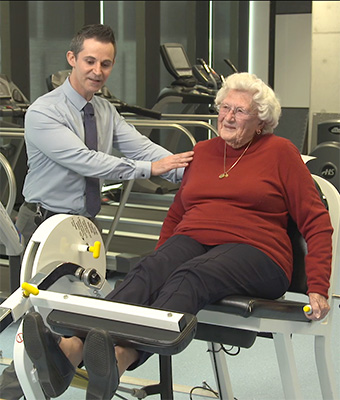Health professionals have a pivotal role in providing their clientele with appropriate exercise prescription.
People living with frailty often have concurrent deficits in balance or endurance. Exercise addressing these areas should be used in combination with progressive resistance training and not as a substitute.
What is frailty?
Frailty is defined as a state of increased vulnerability associated with a decline in physiological functioning and reduced functional reserves across multiple body systems.
People living with frailty are at higher risk of poor health outcomes including hospitalisation, dependency and death.
The role of physiotherapists and exercise physiologists

Frailty has a dynamic pathway and opportunities exist to return those living with frailty to a state of relative vigour.
In scope
As clinicians with expertise in exercise prescription, physiotherapists and exercise physiologists can provide interventions to slow the progression of sarcopenia and mobility impairments in people living with frailty.
Out of scope
Neither physiotherapists or exercise physiologists can independently manage all components of frailty, therefore clinicians should refer people living with frailty to other professionals (such as a general practitioner, geriatrician, pharmacist, dietitian, etc.) to address other manageable components of frailty including malnutrition, polypharmacy and fatigue.
Identifying frailty
All health professionals have a role in identifying frailty. It is recommended that all people over the age of 70 should routinely be screened for frailty using one of many validated assessment tools.
Assessment tools
Screening tools that clinicians can use to identify frailty include; FRAIL scale, Clinical Frailty Scale and Fried’s Frailty phenotype.
Physical assessments such as grip strength, the short physical performance battery and timed up and go, can be used to diagnose and estimate the degree of sarcopenia present in people living with frailty.
Exercise prescription for frailty – specificity matters!
Exercise is strongly recommended for people living with frailty and those at risk of frailty. Programs must be progressive and include high intensity resistance and/or power training to be most effective at treating sarcopenia in this population.
Combine exercises for best outcomes
People living with frailty often have concurrent deficits in balance or endurance. Exercise addressing these areas is often indicated in this population but will not result in the strength gains achieved with resistance training, so should be used in combination with resistance training and not as a substitute.
Progressive resistance training for people living with frailty
Proven to be safe and effective in hospital, community and residential care settings.
Supervised programs achieve better outcomes.
Machines, free weights, bodyweight and isometric exercise are all effective if at appropriate intensity.
Gains made from resistance training are not maintained once training stops, therefore people living with frailty and sarcopenia should be encouraged to permanently incorporate resistance training into their lives.
Prescribing progressive resistance training
Prescribe intensity based on one repetition maximum (1RM) or using the Borg rating of perceived exertion (RPE) scale.
- Strength training: 80% of 1RM or RPE of 15-18.
- Power training: Focuses on rapid concentric contraction and can also be performed at 80% of 1RM or RPE of 15-18. This can achieve simultaneous gains in power, strength, endurance and function.
Perform 2-3 times weekly, 2-3 sets of 8-10 repetitions.
Ensure correct form, including exhaling during the lifting or pushing phase of the repetition.
Borg rating of perceived exertion scale
- Light/easy
- Easy to lift. Can perform 15 repetitions or more without fatiguing
- Moderate/somewhat hard
- Feels somewhat heavy. Can lift between 11 to 15 repetitions, but no more
- Very heavy. Can perform no more than 10 repetitions
- Maximal
- Extremely heavy. Can perform no more than 3 repetitions
We acknowledge the valuable input from the NSW Physiotherapy Advisors Network in the development of this guide.